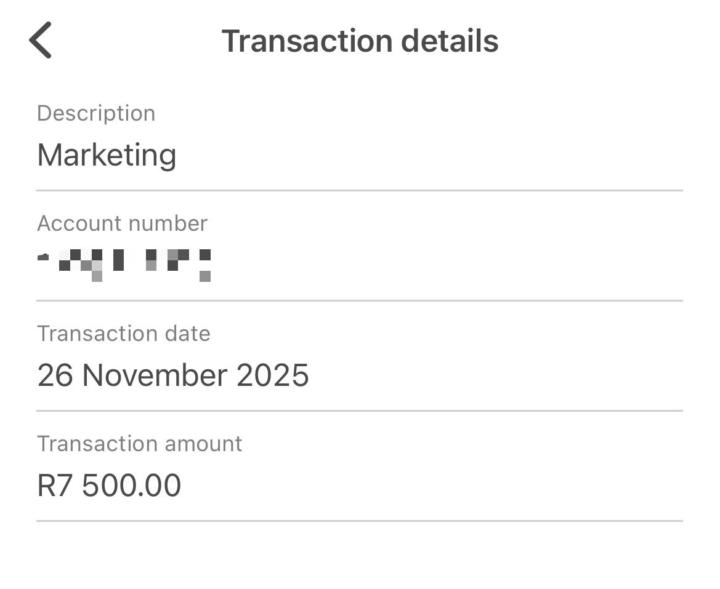Activity
Mon
Wed
Fri
Sun
Jan
Feb
Mar
Apr
May
Jun
Jul
Aug
Sep
Oct
Nov
Dec
What is this?
Less
More
Memberships
AI Automation Mastery
21.8k members • Free
Q's Mastermind
5.1k members • Free
AI Automation (A-Z)
119.2k members • Free
AI Automation Society
212.1k members • Free
Ai Automation Vault
14.6k members • Free
Brendan's AI Community
22k members • Free
AI Automation Agency Hub
275.8k members • Free
7 contributions to AI Automation Society
Client paid me $874,69
Over the past two weeks Helped a local catering business by building them a beautiful website plus a 24/7 AI Agent for their inquiries since their responses are really slow! 50% upfront, 50% upon delivery deal is worth R15K/ $874,69. Wanna get paid? Solve problems and never give up. Took 3 weeks to convince the client cause of back and forths but thanks to shwoing value upfront was able to eliminate all doubts and objections. Projected DONE and completed. NEVER GIVE UP.

First Client At 20 years of age.
Last week Thursday i managed to secure my first client finally after many months of failing and never giving up. It took me 407 days to get my first client but the ups and downs in between were most definitely worth it. This is for a simple Voice AI Agent for their e-com store and a simple n8n workflow. All i can say is fall in love with the work and you will win eventually. To anyone in the AI space keep going!!

GPT-5, Claude 4, Gemini Ultra... doesn't matter. Document processing will still be webhooks and databases.
GPT-5, Claude 4, Gemini Ultra... doesn't matter. Document processing will still be webhooks and databases. Everyone's chasing AI. I'm building boring integrations. Guess who's making money? THE AI HYPE TIMELINE **2021:** "GPT-3 will automate everything!" Reality: Still needed webhooks **2022:** "Machine learning revolution!" Reality: Still needed databases **2023:** "GPT-4 changes the game!" Reality: Still needed error handling **2024:** "Claude 3 is the answer!" Reality: Still needed integrations **2025:** "Just wait for GPT-5!" Reality: Will still need webhooks THE UNCOMFORTABLE TRUTH The AI was never the problem. GPT-4 can read any document? Cool. - How does it receive the document? - Where does the data go? - What handles errors? - Who manages permissions? - How do you monitor it? Answer: Webhooks and databases. MY ACTUAL TECH STACK **The "AI" part:** 5% of the solution - PDF parsing - Data extraction - That's it **The "boring" part:** 95% of the solution - Email monitoring - File handling - Error recovery - Database operations - API integrations - User notifications - Access control - Audit logging **What clients pay for:** The 95% **What tech Twitter discusses:** The 5% CLIENT CONVERSATIONS **What they ask:** "Are you using the latest AI?" **What I say:** "Yes" (it's GPT-3.5) **What they actually care about:** "Will my invoices be in QuickBooks?" They don't care about the model. They care about the Monday morning report. REVENUE REALITY CHECK **Using GPT-3.5:** $8k/month **Using GPT-4:** $11k/month **Using Claude:** $10k/month **Using reliable webhooks:** $19,500/month The difference isn't better AI. It's better integration. THE WORKFLOWS THAT PRINT MONEY 1. **Email → Extract → Spreadsheet** Average client: $2k/month AI involvement: 30 seconds Integration work: Everything else 2. **Folder → Parse → CRM** Average client: $3k/month AI involvement: Process PDF Integration work: The entire pipeline 3. **Form → Process → Database** Average client: $1.5k/month
Stop trying to be an n8n expert. Become a full-stack AI automation architect.
Recently a user named @Nazeef ul hassan Qureshi asked... "As a noob , I think learning n8n is enough but knowing which tool to use when is important, can anyone expert share the details of roadmap to be a full stack Ai Automation expert instead of simple n8n expert" I love this question. It shows you’re already thinking 10 steps ahead. Being an n8n expert is a fantastic skill. You can build powerful things and solve real problems. But you’ve spotted the ceiling: you’re always dependent on someone else’s project. The shift from n8n expert to a full-stack AI automation architect is the difference between being a great mechanic and being an engineer who can design, build, and ship a brand new car from scratch. Let’s break it down. What’s the actual difference? - An n8n Expert connects apps. You are the glue. You take data from point A, transform it, and send it to point B. This is incredibly valuable. - A Full-Stack AI Automation Architect builds entire products. You create the car, the engine, the dashboard, and the user manual. You build systems that people can log into and use directly. The Path to Becoming a Full-Stack Architect: This is a journey, but it’s simpler than you think. You don’t need to learn to code for years. Step 1: Master the Logic (You’re already here!) This is your n8n expertise. It’s the brain of your operation. Keep crushing it. Step 2: Learn to Store Your Data This is the biggest leap. Instead of just passing data between apps, you need a place to store it long-term. This is your database. - Your Go-To Tool: Supabase (or Firebase etc) Think of it as a super-powered Google Sheets. It’s a real, grown-up database (Postgres, one of the most powerful in the world) but made incredibly easy to use. You can create tables, store user info, and track progress without writing complicated code. It plugs right into n8n. Step 3: Learn to Orchestrate Intelligence Go deeper than just the basic AI nodes. Understand how to manage different AI models for different tasks. Use OpenAI for logic, Claude for creative writing, or Gemini for function calling. Your job is to be the conductor of the AI orchestra.
Work Smarter, Not Harder
I’ve noticed something lately… The biggest breakthroughs in business don’t come from pushing harder — they come from removing the things that drain your time and energy. For me, that’s been: ✅ Automating repetitive tasks ✅ Streamlining client follow-ups ✅ Cutting out “busy work” that doesn’t drive results Doing less manual work gave me more space to focus on strategy, relationships, and growth. 👉 I’m curious, what’s ONE thing you’ve done recently that saved you time, energy, or stress?It could be a tool, a system, or even a simple habit. Drop it below, I’d love to learn from your wins!
1-7 of 7




